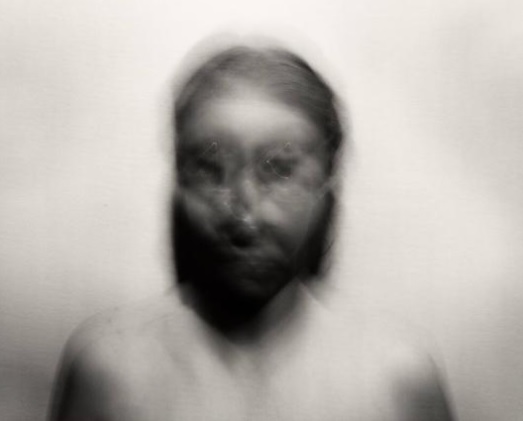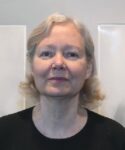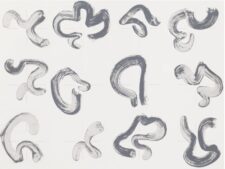
Blythe Bohnen
American, 1940-2022
Self Portrait: Triangular Motion, Small, 1974
gelatin silver print
15 x 19 in.
SBMA, Gift of Herbert and Paula Molner
1992.38.1

Blythe Bohnen - undated photo, A.I.R. Gallery, Brooklyn
“I am interested in the forms that result from the kinesthetic reaction to a given situation. Similar motions in different media are translated into a variety of forms. A single line, a system of points, or a grid define a repeated set of limits that narrows the possibilities for motion so it can be studied. The structure of the form reflects the motions possible for humans: the straight push-pull of the hinge joint and the curves from pivots around a fixed point, or in motion…I am interested in being deliberate about this last outpost of human sensibility.” - Blythe Bohnen

Brushstrokes in a Quadrant, c. 1970
COMMENTS
Photography is often thought of as a medium for freezing or capturing a moment in time. While photographs are indeed still images, photography is also time-based in that light enters the camera and records an image onto film or a digital sensor over a duration in time. Usually this duration lasts just a fraction of a second but, of course, it can be much longer. During longer exposures, which could be several seconds to several hours, time and motion are condensed. Long exposures result in visual outcomes including star trails, light drawings, and “ghost images.” …
Bohnen is a contemporary artist with roots in Minimalism and Conceptualism, working in various media including painting, drawing, and photography. Much of her work focuses on gesture, specifically her own body’s movements in the process of creating marks on canvas, paper, and in photographs. In her series of black and white self-portraits from the 1970s and 1980s, she uses long exposures and predetermined gestures to show motion. The importance of the gesture is evident in how she titles each self-portrait, such as Pivotal Motion from Forehead and Horizontal Elliptical Motion.
The motion, recorded over several seconds of time, produces a blur that obstructs any clear representation of her facial features. Rather, the motion results in abstracted, somewhat unsettling, phantasmatic portraits. By denying a clear depiction of herself, the focus of the image belongs to the motion. The portraits become more of a performance in time, condensed into a single image. Instead of capturing a moment, Bohnen distills the essence of motion.
- M. Paige Taylor, Learning & Engagement Assistant, Asheville Art Museum
https://www.ashevilleart.org/work-of-the-week/self-portrait-horizontal-elliptical-motion-small-blythe-bohnen/
Blythe Bohnen’s body of work is a notable example of the analytical, introspective experiments that occurred in the early years of conceptualism. Beginning her career as a painter, Bohnen explored the effects of gestural motion on canvas through a series of paintings that isolated and amplified individual brushstrokes. Her aim was to capture the process of human motion as it happened in real time, in accordance with her own body. Even the subtlest changes in the pressure and speed of her hand would affect immediate shifts in the thickness and trajectory of each line. …
Like her minimalist contemporaries—many of whom also applied a grid-like structure to their compositions—Bohnen resists any deep metaphorical readings into her work; she insists that every drawing is simply a series of marks on a surface. This keen focus on the physical element of art-making inspired Bohnen to explore a similar process through photography. By centering herself as the subject of the image, Bohnen intentionally distorted the self-portraits with various movements as well as manipulations of camera speed that disrupted any clear representation of her body. Bohnen’s exploration of human gesture across multiple media raises questions about the role of the artist in artistic production, particularly in the wake of ever-evolving technologies. …
Blythe Bohnen was born in 1940 in Evanston, Illinois and attended Boston University of Fine Arts and Hunter College, where she obtained her Bachelor’s degree and Masters in Fine Arts, respectively. Bohnen worked as a lecturer at the Metropolitan Museum of Art, and also as a professor at the Parsons School of Design from 1967 to 1972, during which her fascination with the science of movement deepened. She was the recipient of the National Endowment for the Arts Fellowship in 1978 and has received multiple Artist in Residency Grants.
https://www.airgallery.org/blythe-bohnen
